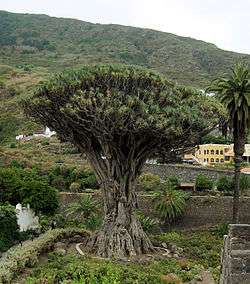Dracaena draco
| Dracaena draco | |
|---|---|
 | |
| The ancient specimen at Icod de los Vinos, Tenerife | |
| Scientific classification | |
| Kingdom: | Plantae |
| Clade: | Angiosperms |
| Clade: | Monocots |
| Order: | Asparagales |
| Family: | Asparagaceae |
| Subfamily: | Nolinoideae |
| Genus: | Dracaena |
| Species: | D. draco |
| Binomial name | |
| Dracaena draco (L.) L.[2] | |
| Synonyms | |
| |
Not to be confused with the related Dracaena cinnabari, the dragon blood tree native to Socotra (an island near Yemen).
Dracaena draco, the Canary Islands dragon tree or drago, is a subtropical tree-like plant in the genus Dracaena, native to the Canary Islands, Cape Verde, Madeira, and locally in western Morocco, and introduced to the Azores. It is the natural symbol of the island of Tenerife, together with the blue chaffinch.[3]

Description
Dracaena draco is a monocot with a tree-like growth habit currently placed in the asparagus family (Asparagaceae, subfamily Nolinoidae).[4] When young it has a single stem. At about 10–15 years of age the stem stops growing and produces a first flower spike with white, lily-like perfumed flowers, followed by coral berries. Soon a crown of terminal buds appears and the plant starts branching. Each branch grows for about 10–15 years and re-branches, so a mature plant has an umbrella-like habit. It grows slowly, requiring about ten years to reach 1.2 metres (4 ft) in height but can grow much faster.[5]
Being a monocotyledon, it does not display any annual or growth rings so the age of the tree can only be estimated by the number of branching points before reaching the canopy. The specimen called "El Drago Milenario" (the thousand-year-old dragon) growing at Icod de los Vinos in northwest Tenerife is the oldest living plant of this species. Its age was estimated in 1975 to be around 250 years, with a maximum of 365 years, not several thousand as had previously been claimed.[6] It is also the largest D. draco tree alive. Its massive trunk comes from the contribution of clusters of aerial roots that emerge from the bases of lowest branches and grow down to the soil. Descending along the trunk, they cling tightly to the trunk, integrate with it and contribute to its radial growth.[7]
Uses
When the bark or leaves are cut they secrete a reddish resin, one of several sources of substances known as dragon's blood. Dragon's blood has a number of traditional medical uses, although dragon's blood obtained from Dracaena draco was not known until the 15th century.[8]
The Guanches worshiped a specimen in Tenerife, and hollowed its trunk into a small sanctuary. Humboldt saw it at the time of his visit. It was 70 feet (21 m) tall and 45 feet (14 m) in circumference, and was estimated to be 6000 years old. It was destroyed by a storm in 1868.[9]
Cultivation
Dracaena draco is cultivated and widely available as an ornamental tree for parks, gardens, and drought tolerant water conserving sustainable landscape projects. It has gained the Royal Horticultural Society's Award of Garden Merit.[10]
See also
Bibliography
- Arkive: Dracaena draco factsheet.
- Dracaena draco in Morocco(photo gallery).
- The climate requirements for Dracaena draco defined by its borders: Northernmost tree in the world, near 40°, northern Azores Islands and Southernmost dragon tree in the world, near 38°, Victoria, Australia (photos).
- Benabid, A. & Cuzin, F. (1997). Dragon tree (Dracaena draco subsp. ajgal Benabid et Cuzin) populations in Morocco: Taxonomical, biogeographical and phytosociological values. Comptes Rendus de l'Academie des Sciences Serie III Sciences de la Vie 320(3): 267-277.
References
- ↑ Bañares, A.; et al. (1998). "Dracaena draco". IUCN Red List of Threatened Species. Version 2006. International Union for Conservation of Nature. Retrieved 11 May 2006.
- ↑ "Dracaena draco", World Checklist of Selected Plant Families, Royal Botanic Gardens, Kew, retrieved 2013-11-12
- ↑ Ley 7/1991, de 30 de abril, de símbolos de la naturaleza para las Islas Canarias - in spanish
- ↑ Chase, M.W.; Reveal, J.L. & Fay, M.F. (2009), "A subfamilial classification for the expanded asparagalean families Amaryllidaceae, Asparagaceae and Xanthorrhoeaceae", Botanical Journal of the Linnean Society, 161 (2): 132–136, doi:10.1111/j.1095-8339.2009.00999.x
- ↑ Dracaena Draco Farm, retrieved 2011-11-03
- ↑ Magdefrau, K. (1975), "Das Alter der Drachenbaume auf Tenerife", Flora, 164: 347–357
- ↑ Krawczyszyn, J.; Krawczyszyn, T. (2014). "Massive aerial roots affect growth and form of Dracaedna draco". Trees Structure and function. 28: 757–768. doi:10.1007/s00468-014-0987-0.
- ↑ Gupta, D.; Bleakley, B.; Gupta, R.K. (2007). "Dragon's blood: Botany, chemistry and therapeutic uses" (PDF). Journal of Ethnopharmacology. 115 (3): 361–380. doi:10.1016/j.jep.2007.10.018. PMID 18060708. Retrieved 2015-02-17.
- ↑
 Gilman, D. C.; Thurston, H. T.; Colby, F. M., eds. (1905). "Dracæna draco". New International Encyclopedia (1st ed.). New York: Dodd, Mead.
Gilman, D. C.; Thurston, H. T.; Colby, F. M., eds. (1905). "Dracæna draco". New International Encyclopedia (1st ed.). New York: Dodd, Mead. - ↑ "RHS Plant Selector - Dracaena draco". Retrieved 18 June 2013.
External links
 Media related to Dracaena draco at Wikimedia Commons
Media related to Dracaena draco at Wikimedia Commons Data related to Dracaena draco at Wikispecies
Data related to Dracaena draco at Wikispecies
